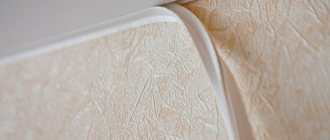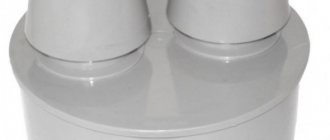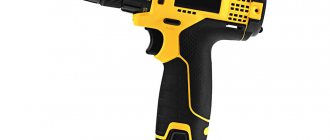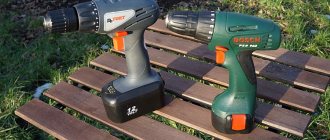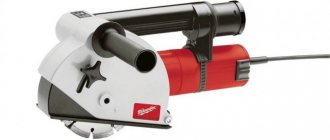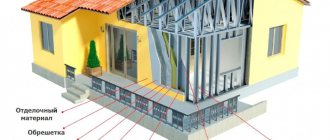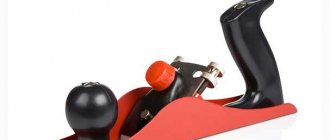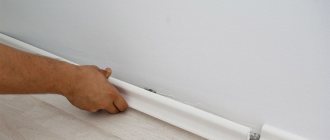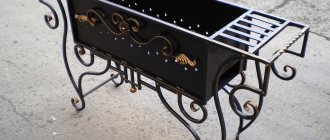SHARE ON SOCIAL NETWORKS
FacebookTwitterOkGoogle+PinterestVk
When performing construction or repair work, it often becomes necessary to cut a metal workpiece. To do this, you should use special equipment in the form of a milling cutter, grinder or hand-held metal shears. However, it is not always at hand. You can cope with this task using a drill attachment for cutting metal, which will cut a product of small thickness.
Thanks to a large selection of different drill attachments, this universal device can replace many other tools
Sheet metal cutting tools
One of the most popular roofing materials is corrugated sheeting or metal tiles. The use of these materials requires high precision and accuracy, so during installation you must use a specialized cutting tool. Installation of sheet roofing material requires cutting it to appropriate sizes, which depends on the technological task. The following types of cutting tools are used for cutting sheet metal:
- Hand scissors for cutting metal are the cheapest tool, which is inconvenient to use when cutting long sheets. The cutting line is uneven, intermittent, and with burrs
- Hand saw for cutting metal - this tool is also not the best for processing sheet material. If you use a hacksaw for metal, then the work should be done only with a blade without a frame, and the cutting process will take a lot of time, so when performing large volumes of work this method is not relevant
- Jigsaw - to cut sheet metal, you will need a special cutting tool, in the spindle of which you need to install a special blade with fine teeth. The disadvantage of this tool is that when cutting, warping of the walls of the sawn product will occur.
- Circular electric saw - when using a circular saw, you will need to install a special disk or circle for metal processing. A circular saw is expensive, so buying one specifically for cutting sheet material is not at all rational
- A grinder or angle grinder is one of the most popular tools that every craftsman has in his arsenal. Using a grinder is convenient, but to cut sheet material, you will also need a special abrasive disc. Moreover, if a grinder is used for cutting sheet metal, then the circle should be as thin as possible. An angle grinder has its drawbacks - overheating of the metal, which entails a violation of the integrity of the paintwork. The result of using a grinder for cutting metal is damage to the material, as it begins to rust, and after a short period of time it may need to be recoated
In addition to the above tools, manufacturers produce special attachments for cutting sheet metal. These attachments are used directly for cutting sheet material; they are also called attachments, since they work in tandem with electric drills or screwdrivers. It is rational to purchase an attachment for an electric drill when large volumes of roofing work are performed.
The drill attachment for cutting metal tiles operates due to a special design, which is implemented through the use of a matrix. The repetition of the movement of the knives contributes to cutting sheet metal with high precision and accuracy. Using an attachment for cutting metal on a drill makes it possible to perform work with high precision and accuracy, which is why it is recommended to buy such a device.
This is interesting!
The attachment under consideration for an electric drill is called nibblers. Structurally, it is similar to hand scissors (depending on the model), but the operating principle is significantly different.
Mechanical cutting methods
The mechanical method is also called cold, since the material is not exposed to high temperatures. The work uses tools whose strength and hardness are higher than those of metal.
- A circular saw. The tool allows you to cut metal at different angles, and with fairly high accuracy. The disadvantage of a circular saw is the shallow cutting depth and large amount of waste.
- Hand scissors . This is a simple device that is relatively inexpensive, but requires significant physical effort.
- Grinder or angle grinder. Convenient for cutting reinforcement, thick sheet metal, and other similar products.
- Machine with band cutter . The machine processes metal at different angles. However, due to the design features, the size of the sheets is extremely limited.
- Guillotine. Such devices are characterized by high productivity. However, they are used only to obtain simple blanks.
- Hydraulic equipment . This is a new word in metal processing technology. Such equipment provides high cutting accuracy, and the thickness of the workpiece can reach 20 cm or more. Not every master can afford expensive equipment.
Video - Cutting corrugated sheets with a grinder
Why is it better to choose metal scissors for a drill?
If you have to cut sheet material, then for such purposes it is better to refuse to use an angle grinder. Scissor-style metal cutting drill attachments provide the following benefits:
- High quality cutting line. Using scissors on a drill or screwdriver allows you to get the highest quality cut when cutting sheet material
- The attachment is suitable not only for electric drills, but also for cordless screwdrivers, as well as pneumatic tools
- It is convenient to carry out work even on the roof if you use a cordless drill or screwdriver
- There is no need to use high-power electric tools
- The ability to perform not only straight, but also curved cuts
- Versatility, which allows you to use the device for cutting any type of sheet material, not just metal
- High productivity - cutting thin sheet steel with a drill using special scissors allows you not only to get a neat cut, but also to achieve results in a short time
- Easy to use - no additional training is required to learn how to use the attachment
- Easy to maintain - the console does not require special care, as it has a simple design. To start using the tool, just attach the attachment to the power tool chuck.
Knowing the advantages of using an attachment for cutting metal, you can make an appropriate decision about the need to purchase it. Many people are interested in the question of how thick sheet material can be pierced by drill scissors.
Manufacturers do not recommend using attachments for cutting sheet material whose thickness exceeds 3 mm. However, it is also worth understanding that cutting such thick metal reduces the service life of the attachment and also requires the use of special powerful power tools.
Drill scissors can be used to cut materials with the maximum permissible thickness (it all depends on the manufacturer of the attachment):
- Aluminum - up to 2 mm
- Stainless steel - up to 1.2 mm
- Regular steel - up to 1.8 mm
- Copper and brass - up to 1.5 mm
To make a curved cut with nibblers, you will need to get the hang of it. Before you start cutting, you need to practice. The operating principle of nibblers is based on converting the rotational movements of the chuck into reciprocating ones. These movements activate the knife, which is responsible for cutting the sheet material.
Although scissors for drills and screwdrivers have many advantages, they are also affordable, so everyone can afford such a useful device. If you plan to cover a house or an extension using metal profiles or tiles, then using a special attachment will not only make the work easier and faster, but will also allow you to carry out manipulations with high precision and accuracy.
This is interesting!
Using a grinder to cut material requires the craftsman to lower it from the roof to the ground, while special attachments on the screwdriver allow cutting directly from above.
"Steel Beaver"
Customer proven unit for cutting flat and perforated steel and composite workpieces. It works on the same principle as Cricket. “Beaver” has a gentle effect on the surface. It does not warp, the edges do not burn. This allows you to preserve the protective polymer coating, protecting the leaf material from destruction. It cuts without sparks, which allows you to perform manipulations near flammable materials.
“Steel Beaver” has a number of technical characteristics that must be taken into account before purchasing:
- Rotation speed range - up to 3000 rpm
- Maximum permissible thickness: sheet steel – 1.8 mm; aluminum and copper – 2 mm; stainless steel – 2 millimeters
- Angle of change of cutting path - 3600
- Circular cutting radius - from 1.2 cm
The final decision regarding the choice of cutting method remains with the consumer. If the work is sporadic and the volumes are small, then it is better to use an attachment. This will reduce the cost of purchasing expensive professional equipment. A conventional drill, through simple manipulations, is upgraded to a full-fledged device for processing steel and composite sheets. The tool's performance is sufficient to cover all household needs, as well as for repairs.
Distinctive features of the Cricket drill attachment
The attachment for drill and screwdriver called “Cricket” is presented in the form of cutting scissors used to create an even cut. They can be used to cut not only steel materials, but also plastic. The manufacturer indicates that scissors can be used not only for cutting sheet material, but also for profiled products.
The Cricket device is used for cutting materials of thickness:
- For aluminum up to 2 mm
- For steel up to 1.5 mm
- For stainless steel up to 1.2 mm
- For plastic up to 2.5 mm
The effectiveness of the attachment also depends on the power tool used. High performance of the nozzle is ensured when using a power tool with the following parameters:
- Electric motor power of at least 400 W
- Chuck rotation speed 3000 rpm
- Key or quick-release collet chuck
The peculiarities of working with a cricket attachment are that the tool has two cutting surfaces. When one surface becomes dull, you need to twist the handle to the other side and continue working. The Cricket set also includes an additional replaceable cutting surface. Manipulating the console is simple. To do this, the attachment shaft is fixed in the tool chuck. Work must be carried out with both hands, holding the power tool with one hand and the attachment with the other.
This is interesting!
If we compare the speed of operation of a drill attachment and a grinder when cutting corrugated sheets, then the latter option is inferior. Even if you manage to cut through sheet metal faster with an angle grinder, compare the quality of the resulting cut to make sure that it is rational to purchase an attachment for an angle grinder for cutting profiled material.
Advantages and disadvantages of use
The attachment can be easily placed on the chuck and removed after use. In addition, the user discovers other advantages of using the equipment, including:
- evenness of the cut;
- absence of burrs on the workpiece;
- work comfort;
- ease of use and installation;
- no need for additional adjustment;
- increase in productivity;
- compatibility of known attachments with an electric or pneumatic drill;
- ease of maintenance;
- possibility of cutting holes.
Attachments for cutting sheet metal, aluminum, and steel have only two drawbacks. The first is that you need to get used to them. Over time, even a beginner in the construction and repair business will master a simple device and learn how to work with it effectively.
The second disadvantage is the need to work with two hands. This complicates the work, for example, when installing a roof, if drill attachments are used specifically for cutting metal tiles.
If you carefully read the installation instructions for metal tiles, you will find a note stating that cutting them with a grinder is strictly prohibited. If the user does so, the product warranty will be void.
This is due to the fact that the top layer of the roof covering is protected on top by a polymer that is not resistant to high temperatures.
A working grinder inevitably heats up, so the polymer layer melts at the cut points, and then the zinc coating. Moreover, sparks flying in different directions will increase the area of damage. The result is disappointing - deformation of the thin sheet metal, the possibility of rust. Therefore, for sensitive materials it is better to look for a nozzle.
Cutting sheet metal with a steel beaver attachment
Another type of attachment for power tools is also used for cutting sheet metal - this is the Steel Beaver attachment. Many craftsmen call such attachments adapters, but they are not such. After all, this is the final mechanism by which useful work is performed.
The steel beaver also works on the principle of cutting shears, thereby eliminating the occurrence of sparks and overheating of the metal. If the sheet material is processed incorrectly, the manufacturer does not guarantee the quality of the overlap or service life. The Steel Beaver set also includes a replaceable die and a punch. The use of the attachment is recommended in conjunction with a power tool that has the following technical parameters:
- The rotation speed of the chuck must be at least 1500 rpm
- Power not less than 350 W
- Collet
Compared to a grinder, special attachments for drills make it possible to change the cutting angle up to 360 degrees. This is convenient when you need to make a shaped cutout in corrugated sheets or metal tiles. The minimum cutting radius when using attachments is 12 mm. The use of a special device is achieved by high cutting productivity of sheet material.
Models in demand on the market
Almost all models on the market operate on the principle of reciprocating rotation of the matrix. The difference lies in the quality of the cut, the maximum thickness of the processed surface, and the cutting speed. Each has a maximum drill rotation speed, as well as a minimum cutting radius. The price depends on these indicators.
Let's consider two popular and user-tested models:
- Scissor attachment “Cricket”
- "Steel Beaver"
Turboshear drill attachment for metal cutting
In addition to the “Cricket” and “Steel Beaver”, manufacturers produce a scissors attachment for drills and screwdrivers called Turboshear. This attachment is more like ordinary hand-held metal scissors. Structurally, the nozzle is based on two cutting edges. One edge is movable and the other is fixed. Due to the reciprocating movements of the movable edge of the attachment, the material is cut. Among the advantages of the Turboshear nozzle it should be noted:
- High speed of work completion
- Ability to cut while holding the tool with one hand
- Ease of use
The disadvantage of the Turboshear attachment is that the slightest dulling of the cutting edges reduces the performance of the tool, and the cut results in burrs and chips. To restore the functionality of the device, you will need to replace the knives.
There are many other models of scissors for drills and screwdrivers. Which nozzle is better to buy, it all depends on the amount of work and the technological tasks set. Steel Beaver and Cricket are not expensive compared to Turboshear. The Turboshear nozzle is made in the USA and has high performance and long service life.
Design and principle of operation
Before you start using a device for cutting metal, you need to familiarize yourself with its design in order to understand how workpieces are cut. The tool consists of several elements:
- A bearing with a freely rotating shaft that transmits force to the blades of the equipment.
- Two blades. One of which is fixed to the frame, and the other to the axis.
- Handles.
- Fastening elements.
The operating principle can be compared to a crank mechanism, but in this case energy is supplied for rotation.
You cannot operate a power tool without a special handle, which is included with the equipment. When cutting metal parts, a drill or screwdriver may rotate around its axis under the influence of torque. The workpiece will be damaged and the master will be injured.
Cordless scissors (Photo: Instagram / men_instryment_)
Differences between using an attachment on a drill and a screwdriver
An electric drill and a screwdriver differ not only in purpose, but also in design. The attachment for cutting thin sheet metal can be attached to both drills and screwdrivers. It is important to consider the following factors:
- A screwdriver has a lower chuck rotation speed compared to a drill. The screwdriver also has low power, so when cutting sheet steel you need to choose the right tool
- Ease of use. Unlike a drill, a screwdriver has less weight, and it is not tied to a power cord. This makes it easier to use as a drive mechanism for metal snips
- Lack of inertia - after the power supply is cut off, the screwdriver chuck stops immediately, but on a drill it continues to rotate for some time. When performing high-precision work, the quick stop of the power tool chuck is even better, as it responds more accurately to the press of a button
A screwdriver, like a drill, can be used for cutting sheet materials, but it is necessary to choose a power tool wisely.
Why is it worth paying attention to this particular tool?
This is an effective alternative to its main competitor - the angle grinder. The advantage is achieved due to a number of mechanical and operational parameters:
- High quality cut. The metal does not bend, the cutting edge is smooth, not burnt
- It is completely ready to use. No need to purchase additional spare parts and consumables
- Ease of use when working in areas with limited movement area, such as pitched roofs
- High performance
- The equipment is suitable for installation on both electric and pneumatic drills
- The attachment allows you to make cuts of complex shapes, for example, cutting a round hole in the center of a sheet without cutting it through
How to cut profiled sheet material with a nozzle
To connect the attachment to a power tool, the design of the attachment has special protrusions - shanks. Typically, shanks are hexagonal in shape and are clamped into the collet chuck of the power tool. After securing the shank in the power tool chuck, you can begin to work. When performing work, it is important to follow these recommendations:
- If the work is being carried out for the first time, it is recommended to first practice on the remains of sheet materials
- Work is carried out by holding the tool with both hands. This is necessary not only to comply with safety regulations, but also to ensure that the cut is smooth and neat. If you perform work while holding only a drill or screwdriver, the attachment will vibrate strongly, and therefore you will not be able to get an even cut. The exception is Turboshear brand consoles
- It is better to carry out work below (not on the roof) from a safety point of view, although in exceptional cases it is possible to use tools above
- To get the highest quality cut, you need to carry out the work with an assistant. One person holds the sheet to be cut, and the second does the actual work of cutting the material.
- Before starting work, you need to use a marker or pencil to make markings along which to cut thin-sheet material.
In order for the cuts to be neat, even and without defects, you need to learn how to use the tool correctly. This will take practice.
To summarize, it should be noted that buying an attachment for cutting sheet material is recommended for specialists who deal with roofing houses and other buildings using steel sheet material. If you plan to cover a shed or other outbuilding yourself, then using a drill attachment for cutting metal, you will be able to complete the work with high precision and accuracy.
Master Class. How to make a lathe from a drill
You might be surprised, but a drill can also be used to create a simple lathe. All structural elements are made by hand (with the exception of screws and bearings). There is nothing superfluous - only the most necessary!
Step 1. The first thing you need to do is prepare everything you need for the job.
Step 2. Next, you need to decide what the dimensions of the tabletop will be. It is not necessary to take the sizes given in the example - you can have your own.
On a note! The dimensions of the tabletop depend on the dimensions of the drill and the dimensions of the workpieces to be processed.
Step 3. After this, the center of the drill is determined. It is placed on the tabletop, then the distance from it (the tabletop) to the center of the chuck is measured. Take a square piece of wood and make a hole in it for the neck of the drill. The center of this hole will be the previously measured distance. This will ensure the drill stays level.
Step 4. All excess is cut off, after which the mount must be put aside for a while.
Step 5. We begin assembling two corner pieces, which are a pair of rectangular pieces of wood glued together.
The smaller part (headstock) will hold the rotating workpiece from the opposite side, and the larger one is the bed, the tool itself will rest on it. It is important that the height of the headstock is approximately 1.5 times greater.
Then guides are created on both workpieces - holes are drilled along the line, which are then connected at an angle.
Step 6. 3 important elements are ready. If you want, spray paint them.
Step 7. A hole for the bearing is drilled in the headstock (it should not be through). A bolt is inserted into the bearing itself and tightened with a nut. Glue is applied to the seat, then the bearing is installed (it should be with the nut facing out).
Step 8. The rail guides are attached to the tabletop. Holes (3 pieces) are drilled for long bolts, the mount for the drill is fixed with self-tapping screws. You also need to install a small wooden rectangle under the handle of the drill. All parts are screwed on.
Step 9. The drill itself is fixed with self-tapping screws - it should “sit” rigidly.
Step 10. The design is almost ready, all that remains is to make a clamp to hold the workpiece. For this purpose, a round piece is cut out, self-tapping screws are inserted into it, as well as a bolt and nut.
Step 11. The finished part is mounted in the chuck.
Video - How to make a lathe
Other types of nozzles
When it is not possible to make a hole in the usual way, you need to use an angle attachment for a drill. The working head of such a device can be rotated at different angles relative to the axis of rotation of the drill chuck. The main disadvantage of the equipment is the increased risk of drill failure. Therefore, the most popular is the 90-degree angle attachment for a drill, which is fixed on the neck of the drill. The price of the product is on average 800 rubles.
For craftsmen who make furniture, various types of cutter attachments are in great demand. They can be backed and pointed. With their help, you can make grooves of different shapes and depths, process holes and remove defects. The cost of equipment is in the range of 350-450 rubles.
The design of the teeth of the cutter attachments ensures soft cutting into the workpiece and can be sharpened many times
To mix solutions of different consistencies, use a mixer attachment for a drill, which is selected taking into account the density of the solution. Thus, for mixing glue, liquid putties and other fluid mixtures, spiral-shaped devices are used that prevent splashing of the solution. To mix concrete, nozzles with a hexagon-shaped tail are used. Mixing mixtures using this attachment will be done quickly and efficiently. However, in order not to reduce the efficiency of the device, the volume of the mixture for mixing should be maintained. The price of the nozzle is 500 rubles.
Helpful advice! When choosing a mixer attachment for a drill, you need to consider the power of the tool. Increasing the load can lead to winding burnout.
An indispensable tool for concreting is a concrete vibrator attachment for a drill, the price of which is about 900 rubles. It is used to compact the concrete mass during its laying, namely, it is intended to remove bubbles and air from fresh concrete. The attachment requires a drill with a power of at least 1500 W.
To perform wood turning work, a home craftsman simply cannot do without a drill attachment for cutting wood, the average price of which is 2,000 rubles. To pump liquid, you can use a pump attachment.
The material used to make the impeller of the mixing attachment affects what substances can be mixed with it.
A wide selection of different attachments, attachments and accessories makes the drill a universal tool, which is indispensable when performing repair work and for other household needs. This is a simple and optimal solution that will allow you to avoid purchasing expensive specialized power tools.
Safety precautions
Regardless of the brand of drill and attachment, their price and characteristics, it is very important to follow safety precautions.
Drill Safe Practices
This will prevent injury and damage to the material.
- When working with a drill, you need to wear safety glasses and gloves.
- Before starting work, it is important to check the attachment of the nozzle.
- Be sure to check whether the material to be cut is well secured.
- The drill must be held with both hands using special holders.
- When working with a metal cutting attachment, constantly remove falling chips. For example, when installing a roof, a large amount of chips can damage the surface of the metal tile.
- After completing the work, do not touch the treated metal with your hands for some time and remove the attachments, as they may heat up due to friction.
So, when we cut metal sheets up to 2 mm thick, for example, when installing metal tiles or a fence made of corrugated sheets, and the amount of work is small or one-time, then it makes sense to turn your attention to drill attachments.
Finally
And yet, if you are not a professional roofer, then you won’t find a better option than a drill attachment . It can be an excellent help both on the roof and in everyday life. If you need to cut metal without squealing and fiery splashes, like from an angle grinder, please do so. In addition to the convenience of operation, the fact that you do not need to buy an expensive device is captivating. The attachments themselves are not that expensive and fit on any drill. For professional work with metal tiles, such attachments are rather weak, but for home use they are the best option.
Whatever you use to cut, it is better to treat the cut edges with paint , such as façade paint.
Specifications
Any device for cutting metal has certain technical characteristics, on which the performance and accuracy of the cuts depends. Parameters to consider when choosing devices:
- type of processed metals;
- dimensions of working parts;
- the optimal number of revolutions for the normal functioning of the equipment;
- what force should be applied when cutting the workpiece.
The cutting parts of the equipment must be made of metals of increased hardness.
